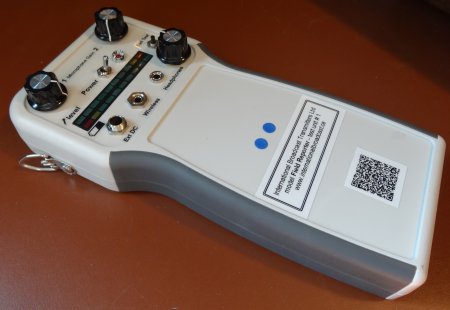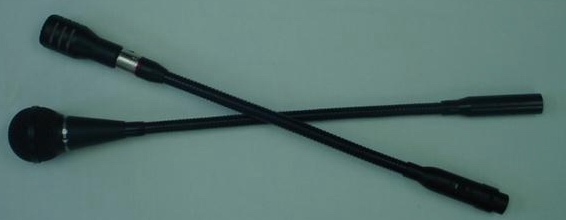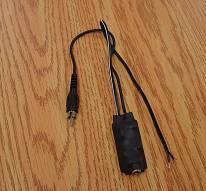Audio Equipment
This equipment is available to augment or upgrade existing radio
stations.
Six Channel Audio Mixer
This particular unit features four line inputs and two
microphone inputs (high and low impedance), all via RCA
connectors. It can operate in both mono or stereo and has a dual
channel visual modulation level display. It has a channel
pre-selection for cue and control as well as an audio monitor
(headphone) level control. The unit operates directly from 13.8
Volts DC, making it very useful for certain isolated community
stations. It also features dual high and low level outputs
for
connection to a radio broadcast transmitter, to an audio line
amplifier for outdoor public address broadcasts, or to both
simultaneously.

Click on Image for a larger view
Field Reporter wireless phone interface
The FIELD REPORTER handheld wireless phone interface is used
for relaying audio from the field to a studio, whether it be a
sporting event commentary, reporting at live events, or field
interviews. A radio station commentator or reporter can relay
audio to the radio station’s studio using a FIELD REPORTER
connected to a wireless phone dialled into a studio landline
phone, where that line is interconnected to a broadcast console
or mixer. Alternatively, a second FIELD REPORTER unit can be
used at the studio if a wireless phone is also used there.
Field Reporter
features and instructions


Click on Image for a larger view
Telephone land line to console patch
The LL-PATCH telephone interconnect is used for interfacing a
dial-up landline telephone line (or fixed phone line) to a
studio console, such as the Wantok-SBS-1 or SBS-2, or any other
studio console or audio mixer, where a single audio mixer
channel is used. This permits the broadcast station to
conduct live interviews or broadcast live feeds originating over
the telephone network. Examples are field reporting and
telephone interviews initiated at the studio.
LL-Patch features and
instructions

Click on Image for a larger view
Studio to transmitter link isolator /
amplifier
The main application for this two channel (stereo), split box
system is for long studio to transmitter audio cable runs. Using
balanced audio lines increases the common-mode rejection ratio,
thereby reducing noise and AC hum seen with unbalanced
lines. Selectable audio amplifiers supply gain if required
for long lossy cable runs.
STL-ISOAMP
features


Click on Image for a larger view
Audio isolation interface
This unit can be used in any mono or stereo audio chain,
providing isolation between equipment connected to either side
of the isolation transformer, reducing issues of ground loops,
noise, and hum. Additionally, the unit provides both balanced
(XLR) connections and unbalanced (¼” phone or phono) connections
on both sides of the isolation transformer.
ISO-BALUN
features
MP3/CD Player
The MP3/CD player is
capable of playing both MP3 recorded compact discs and regular
compact discs.
CD operating features
include continuous play, skip track search, pause/cue
capability, random play, programmed play, repeat play and
introductory scan. These units have a digital buffer
memory that stores up to 60 seconds of play to prevent skipping
if the console is accidentally bumped.
MP3 operating features will
support a maximum 256 directory MP3 discs or a maximum 512 track
(file) MP3 discs. All of the play mode features of the CD
player also apply to the MP3 discs. In addition, it features
Directory Playback and Directory Program.
 Click on Image for a larger view
Click on Image for a larger view

Tape Cassette Recorder / Player
These units feature full play and record capability. They have
pause and cue with a mechanical tape counter to assist in
locating various tracks on the tape, they readily plug in and
out of the console and come with an additional microphone, edit
plug and edit cord to permit field recording and editing of
local material. These units utilize standard 30, 60 and 90
minute cassette tapes.
 Click on Image for a larger view
Click on Image for a larger view


Microphones
These units are a high-quality, high sensitivity, wide range
unidirectional microphones. The flexible neck permits easy
adjustment for individual operators. Their directional pickup
pattern cuts down on unwanted background sounds and allows
greater distance between the microphone and the sound source
reducing feedback problems. They feature a wire mesh screen to
cut down on breath pops and an XLR connector for a balanced low
impedance connection.
Click on image for a larger
view 



In-Line amplifier

This is a small audio amplifier
that simply plugs into any audio line using RCA jacks. It
requires 12 Volts to operate and it efficiently boosts any
audio signal. On the Wantok-SBS-1 and Wantok-SBS-2 studio
console, the 12 Volts may be tapped right off the audio board or
from the auxiliary 12 Volt source on the back of the
panel. For more information, see the In-Line Amplifier page.
IBT Products
Page created by D. Lemoine
Copyright © 2013. All rights reserved.
Information in this document is subject to change without
notice.
Other products and companies referred to herein are trademarks
or registered trademarks of their respective companies or mark
holders.
Send mail to Webmaster with questions or
comments about this web site.
Last modified: November 13, 2013










